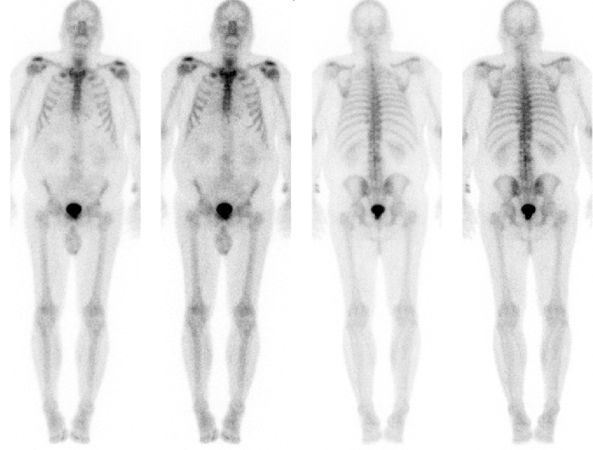nuclear medicine

Bone scintigraphy
-
You do not have to be fasting on the day of the examination, you can take your medication
-
Allow about 3-4 hours for a complete examination.
-
Bring something to drink and, if necessary, something to eat
A low-level radioactive agent is injected into a vein in the arm. The radiation exposure of the examination is low, slightly less than with a CT scan. This remedy makes the bone metabolism visible to us and thus, for example, joint inflammation, rheumatism, bone fractures, malignant changes, loosening of artificial joints or wear and tear can be detected. Depending on the question, an image is taken immediately after the injection, which takes about 15-20 minutes. You will then have a break of about 2 hours. You should drink a liter of liquid during this time and be allowed to move freely. You will be given an exact time when you have to be back for the recordings. These recordings take about 3/4 of an hour.
Myocardial scintigraphy (cardiac examination)
-
Get our information sheet for this examination.
-
Read it thoroughly.
-
the most important points: You must be fasting on the day of the examination, but you must be allowed to drink water, you must pause your heart medication
-
Bring a medication plan and previous findings, if any.
-
Bring something fatty to eat (e.g. rolls with cheese or liver sausage) for 2 meals as well as your medication.
-
Allow about 4-5 hours for the examination
Investigation
This examination provides information about the blood flow conditions in the heart and the function of the heart muscle. An examination is first carried out under stress and then usually also at rest. The load will be either with a drug or with an ergometer (bicycle). During the exercise, you will be injected with a small amount of a radioactive substance, which is then distributed in the heart muscle tissue depending on the blood flow. 30 minutes later you need to eat the first fatty meal, and another 30 minutes later the first intake occurs.
For the rest examination, a radioactive substance is injected again, but without prior exposure. You should also eat a high-fat meal 30 minutes after this injection. The 2nd recording is about 30 minutes later.
Thyroid examination
-
You do not need to be sober on the day of the examination.
-
You may take your thyroid medication on the day of the examination, unless otherwise discussed.
-
Allow about 90 minutes for a complete examination of the thyroid gland.
The small butterfly-shaped organ in the lower part of the neck has an important function for many metabolic processes. There may be both structural (enlargement, nodes) and functional changes (hyper- or underactive) of the thyroid gland.
Investigation
First, complaints/problems are raised in a conversation and an ultrasound is performed to record the size of the organ and any nodules that may be present. If necessary, a scintigraphy is then performed. For this purpose, a low-level radioactive agent is injected into a vein in the arm. The radiation exposure of the examination is low and roughly comparable to that of an X-ray. After a waiting period of 10-20 minutes, a picture (scintigram) of the thyroid gland is taken. You sit in front of a gamma camera for about 5 minutes for the recording.
Renal scintigraphy
-
You should not have had a CT scan with contrast agent in the last 48 hours
-
In the last hour before the examination, you should drink 3/4 liter (750ml) of water
Investigation
This examination provides information about kidney function, for both the right and left kidneys. While you are lying on a couch of the camera, a low-level radioactive agent is injected into a vein in your arm. The radiation exposure of the examination is very low. The recording lasts 30-45 minutes.
RSO – Radiosynoviorthesis
In the case of painful inflammatory changes in the knee joint, we carry out this therapy. First of all, an explanatory discussion takes place. This will check whether this therapy is suitable for you and you will be informed in detail. During therapy, the knee joint is punctured with a thin needle by a nuclear medicine specialist. Subsequently, a radioactive substance is injected directly into the diseased joint and leads to irradiation of the affected synovial membrane. The inflamed tissue is thus destroyed and the pain is eliminated or at least significantly alleviated as a result. After the treatment, the joint must be immobilized for 48 hours and should be rested for about a week. As a rule, there is a significant improvement in the symptoms within 3 months. This lasts an average of 2 years. Repetition of therapy is possible.
Further investigations:
lung scintigraphy
Selentinel lymph node scintigraphy
datscan
gastric emptying scintigraphy